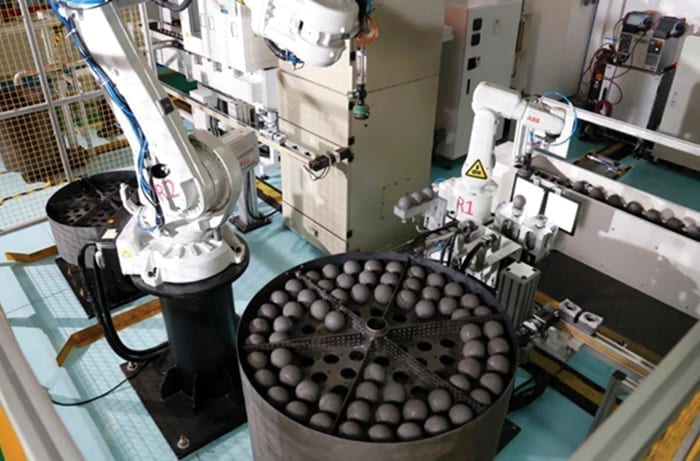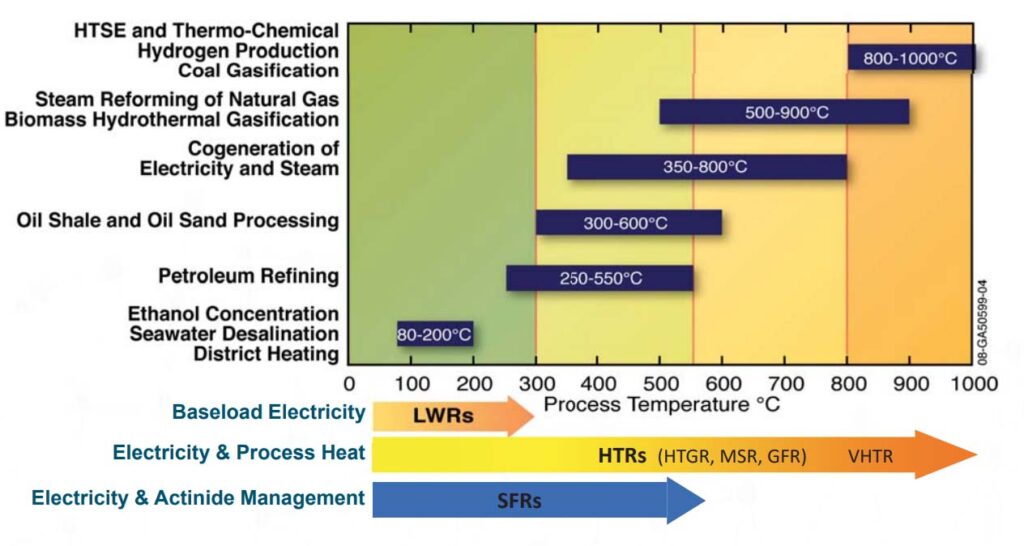China Starts Up First Fourth-Generation Nuclear Reactor

The first of two units at China's much-watched high-temperature gas-cooled modular pebble bed (HTR-PM) demonstration project was successfully connected to the grid on Dec. 20. The achievement marks a major milestone for fourth-generation advanced nuclear technology.
 |
The demonstration high-temperature gas-cooled reactor pebble-bed module (HTR-PM) at the Shidaowan site in Shandong Province of China was connected to the grid in December 2021. Courtesy: China Nuclear Energy Association |
Grid-connection of Unit 1 at the national project" at the Shidao Bay site in Rongcheng, Shandong Province, will be soon followed by Unit 2. When commercially operational as expected in mid-2022, the two HTR-PMs will drive a single 210-MWe steam turbine. Construction of the pioneering project began in December 2012, led by China Huaneng (which holds a 47.5% stake in the demonstration), along with China National Nuclear Corp. (CNNC) subsidiary China Nuclear Engineering Corp. (CNEC, 32.5%), and Tsinghua University's Institute of Nuclear and New Energy Technology (20%). Chinergy, a joint venture between Tsinghua and CNEC, served as the engineering, procurement, and construction contractor for the nuclear island.
Decades of DevelopmentAs Tsinghua's Institute of Nuclear and New Energy Technology has noted, the demonstration project stems from a series of developments that marked a qualitative leap from laboratory to engineering application." High-temperature gas-cooled reactor (HTGR) technology has been explored for decades. China's own HTGR research and development program kicked off in the mid-1970s, echoing similar government-led initiatives to develop the 200-MWth HTR-module of the Siemens/Interatom Co. in Germany, and General Atomics' 350-MWth modular high-temperature gas-cooled reactor MHTGR in the U.S.
China's research institutions eventually accomplished the construction of the HTR-10 test reactor in the late 1990s. In February 2008, China approved the 200-MWe HTR-PM demonstration plant as part of its slate of National Major Science and Technology Projects. As Tsinghua noted, the government then anticipated the technology would prove to be a highly efficient nuclear power technology, as a supplement to pressurized water reactor [PWR] technology." Chinese researchers also heralded the technology's high-heat potential, as well as the opportunity to further global innovation in advanced nuclear technologies. A key focus was to improve nuclear safety inherently.
Pebble-Bed ModulesThe HTR-PM demonstration comprises two pebble-bed reactor modules-each which consists of a reactor pressure vessel, graphite, carbon, and metallic reactor internals-a steam generator, and a helium blower. The thermal power of one reactor module is 250 MWth, the helium temperatures at the reactor core inlet/outlet are 250/750C, and steam at 13.25 MPa/567 C is produced at the steam generator outlet," Tsinghua said.
Among the HTR-PM's distinctive differentiators, when compared to PWR technology, for example, is that it uses helium as a coolant. An HTGR does not use water cooling' but air cooling' for core cooling and heat transfer-that is, the coolant is a gas. As an ideal inert gas, helium has stable chemical properties, does not easily react with other materials in the reactor at high temperatures, and has good thermodynamic properties," it explained. In addition, unlike light water reactors and heavy water reactors that use water and heavy water as moderators-materials that help slow down the speed of neutron movement and sustain a fission reaction-HTGRs use graphite as the moderator, mainly for its good high-temperature resistance.
The HTR-PM, specifically, also adopts a modular design. The core idea is to split a large [megawatt-sized] reactor into 10 small modules, each of which is a small reactor that can operate independently," Tsinghua said. Each small module can use a very low power density," about one-thirtieth of that of a large PWR nuclear power plant, it said. In the event of an accident, even without active cooling, the residual heat of the reactor core can be safely dissipated through basic phenomena, such as heat conduction and thermal radiation after the reactor is shut down." Modularity also translates to scalability, as well as flexibility, it said.
Yet another notable aspect of the pebble-bed design is that it uses a heat-resistant all-ceramic-coated particle spherical nuclear fuel element. The fuel spheres used at the Shidaowan HTR-PM demonstration are graphite-coated balls (six centimeters in diameter) made up of about 12,000 four-layer particles dispersed in a graphite powder matrix, it said.
 Fuel loading at the Shidaowan high-temperature gas-cooled reactor pebble-bed module (HTR-PM) in China began in the spring of 2021. It involved putting 870,000 spherical TRISO fuel elements into the two small reactors that will drive a single 210-MWe turbine. Courtesy: China National Nuclear Corp. (CNNC)
Fuel loading at the Shidaowan high-temperature gas-cooled reactor pebble-bed module (HTR-PM) in China began in the spring of 2021. It involved putting 870,000 spherical TRISO fuel elements into the two small reactors that will drive a single 210-MWe turbine. Courtesy: China National Nuclear Corp. (CNNC)
Tsinghua expects the HTR-PM's high heat production will be beneficial on multiple levels. At present, about 40% of the world's energy is utilized in the form of electricity, and the rest are non-electrical applications, including industrial heat, residential heat, and transportation energy utilized in various forms. There is a great demand for high-temperature process heat in various industries," it noted. The helium outlet temperature of the Shidaowan HTR-PM demonstration can reach 750C, producing superheated steam of 566C. In addition to high-efficiency power generation, high-temperature steam can also be used for cogeneration, thermal recovery of heavy oil, chemical industry, metallurgy, and so on," it said. If development further boosts temperatures to 950C, as tests at the HTR-10 suggest, the technology's heat may also be used for large-scale hydrogen production, providing more wide-ranging decarbonization solutions, it said.
 Some process heat applications suitable for nuclear. Notes: HTSE = high-temperature steam electrolysis; LWRs = light water reactors; HTRs = high-temperature reactors; MSR = molten salt reactor; GFR = gas-cooled fast reactor; VHFR = very high flux reactor. Source: Idaho National Laboratory, 2019
Some process heat applications suitable for nuclear. Notes: HTSE = high-temperature steam electrolysis; LWRs = light water reactors; HTRs = high-temperature reactors; MSR = molten salt reactor; GFR = gas-cooled fast reactor; VHFR = very high flux reactor. Source: Idaho National Laboratory, 2019
Success at the Shidaowan demonstration project could prompt several similar projects. CNNC said it plans to further strengthen its partnership with Tsinghua University to accelerate deployment of the HTGR technology and establish an advanced nuclear industry in the nation. For now, a further 18 HTR-PM projects are proposed for the Shidaowan site. Proposals also call for a scaled-up version, the HTR-PM600, which would comprise six HTR-PM reactor units driving a 650-MWe turbine. According to the World Nuclear Association, feasibility studies on HTR-PM600 deployment are underway for Sanmen, Zhejiang Province; Ruijin, Jiangxi Province; Xiapu and Wan'an, Fujian Province; and Bai'an, Guangdong Province.
-Sonal Patelis a POWER senior associate editor (@sonalcpatel,@POWERmagazine).
The post China Starts Up First Fourth-Generation Nuclear Reactor appeared first on POWER Magazine.